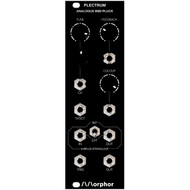Plectrum - Morphor
by Alex Vittum
A trigger initiating a burst of white noise fed into a filtered delay line…I was intrigued when I discovered this is how the Morphor Plectrum creates its compelling plucked string-like sounds that are both percussive and melodic. This simple design and layout makes this module very approachable, though it’s far from ordinary. The richness is in the relationship between tune, feedback, and the color parameters where there are seemingly countless points of timbral wonder, and adventurous exploring has rewarded me with sessions where time slipped away in all the excitement, with recording I made being proof that I was witness to this module f—king freaking out, but more on that later!
The Plectrum is an 8hp all-analog module that, like the rest of Morphor’s line of modules, is well built and elegantly simple. The pots have a great feel and the tall, slender knurled knobs make for confident, incremental movements. Rather than employing the more common method of wavetable synthesis for Karplus Strong, the Morphor Plectrum uses a BBD delay line, courtesy of a 1024 stage MN3207 BBD chip, to make multiple copies of the triggered noise impulse. The delay time is calibrated for very short delay times, so don’t expect it to react like your favorite BBD delay pedal; it's not that. Plectrum is tunable via its 1V/Oct input, whereupon pitch is essentially modifying a delay time, like slowing down and speeding up a tape machine.
The timbre grows darker as the delayed signal extends, producing a very natural string or drum sound, and this form of acoustic modeling brings an impressive amount of realism to the scene for an analog circuit. Being a delay circuit at the core, the Feedback parameter will either extend or shorten this natural decay, though like many delays, the Feedback beyond two o’clock will cause self-oscillation and can bring a wooly chaos to the party, which sounds really good. Be mindful though, that when experimenting you should patch the output of Plectrum through a mixer or some attenuation to mitigate any unwelcome surprises for your ears.
A trigger signal initiates a white noise burst, and Morphor specifies an optimum duration of about 5ms for the trigger. The short duration is essential to activating the white noise just enough to ring, but not enough where one perceives it as white noise, though you can use a gate source with some flexibility and achieve good results. For my initial experiments, I used the Intellijel Metropolix sequencer, where gate length and percentage (scale) can be adjusted. It turns out that patching a sustained voltage high enough at the trigger input will produce constant white noise that’s shapeable by the feedback and filter, so you can add white noise generator to Plectrum's feature list.
The 1dB lowpass, non-resonant filter, functions mostly as a tone control and delicately attenuates the high frequencies, and alternately, the Karplus Strong “loop” section provides a send and return loop that allows bypassing the internal filter for an alternate signal chain. I patched in my System80 860 filter set to bandpass, and the ALM MFX effects processor for some 12-bit digital reverb vibes, and the bandpass provided great tonal control while the reverb softened and extended to signal in a compelling way. Plectrum's toggle switch set to EXT (external) enables the loop, while the INT (internal) switch setting blends with the Plectrum filter and delay line. In the latter case, you can add volume control to the effects chain and blend to taste, and as my curiosity persisted I arranged the loop circuit in reverse, with my System80 810 synth voice patched to the Input, allowing it to flow through the Plectrum’s delay and filter signal path. Signal processing; another feature added to Plectrum's growing list.
Once I got my bearings with the basic principle, I patched in some CV control using three triangle LFOs to modulate Tune, Feedback and Color (filter), and this really opened up a new chapter of Plectrum. Only the Tune parameter has a dedicated attenuator, so I suggest patching attenuation between the modulation source and Plectrum for more control. The Feedback CV input, which is new to this version of Plectrum, is particularly interesting to modulate as it behaves much like a variable release time. Coupled with filter and pitch modulation the sounds go in a lot of great and surprising directions; rhythmic pulsing, clicking, strumming and textural drones come easily and expand from there.
The Plectrum documentation is sufficient, though I recommend checking Morphor’s YouTube demo for a very nice overview. They suggest a few interesting patching hacks, like patching the loop (set to INT) out to the Tune CV control for an interesting shift in timbre, as the audio output is essentially modulating its own pitch input. They also suggest experimenting with shaping the sound using a VCA and in one instance I duplicated the gate output of the Metropolix sequencer and simultaneously triggered both the Plectrum and the VCA it was patched into. What I love about this approach is that it allows the shaping of the attack with the freedom to let the module freak out with all kinds of modulation, yet it still maintains some order, because despite what the Plectrum is doing, ultimately the note duration is dictated by the VCA, which allows you to experiment more with sustained feedback as well as the attack.
High quality, yet affordable modules with a focused approach makes Morphor a really appealing brand and I’ve noticed their product line is becoming more widely available. I’m looking forward to exploring more Morphor modules like their dual ADSR, and their LFO and delay module. As for Plectrum, I’ve enjoyed discovering the treasure trove of sounds in it, and I plan to keep it in my system for a long time.
Price: $199


